Travel back to the time of the Romans by visiting Pompeii, Italy. This world famous archeological site is a complete footprint of the ancient city and reveals a way of life that was destroyed when the volcano Vesuvius erupted in AD79. Our guide includes top things to do in Pompeii, the pros and cons of guided tours and tips on visiting Pompeii from Naples.
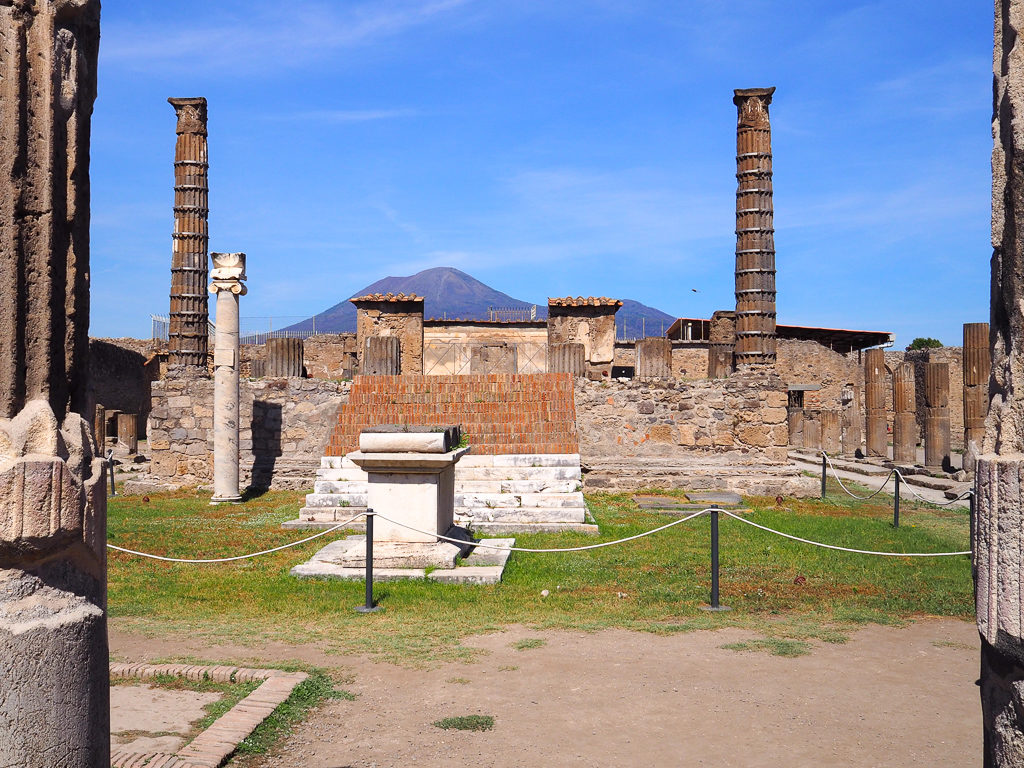
This post contains affiliate links, this means that I may receive a commission at no cost to you if you click a link and make a purchase. As always all opinions are my own.
Is Pompeii Italy worth visiting?
Almost 2000 years ago the volcano Mount Vesuvius erupted catastrophically in the region of Campania on the west coast of Italy. It engulfed the entire Roman town of Pompeii and obliterated it under deep layers of lava and volcanic ash.
The devastation was so complete that the site was abandoned. Astonishingly it wasn’t excavated until it was accidentally re-discovered in the 1700s. Since then, bit by bit, archeological digs have been revealing what is left of the city from 79 AD.
And what they have revealed is extraordinary. The lack of air and moisture under the ash has preserved Pompeii in incredible detail. Roman streets, homes and shops, paintings and plumbing, even graffiti are all on view at the archaeological site of Pompeii today. This ancient Roman city is now a UNESCO World Heritage site and the ruins of Pompeii and their tragic story have captured imaginations all over the world. It’s a must-see if you’re visiting Southern Italy.
Visiting Pompeii Italy: top tips
How long does it take to visit Pompeii?
We stayed for half a day which is enough time to take in most of the highlights if you’re organised. Our guide showed us an excellent cross-section of the town but we could have easily stayed much longer.
There’s enough to see to fill one, two or more days at the site. But we combined our visit to Pompeii with a trip to Mt. Vesuvius in the afternoon so we needed to move on.
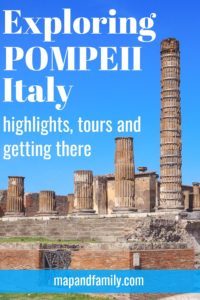
Like this post? Please pin this to save and share to Pinterest
Best time to visit Pompeii
This depends on what else you have planned for your itinerary and when you’re able to travel. The months of November to February in the region are more likely to be colder and wetter than at other times of year, and consequently Pompeii is less busy.
The high season months will be correspondingly hot and popular and it’s worth noting that there’s very little shade on the Pompeii site. Check the opening times and you’ll see the site has longer hours in the summer to compensate for this.
By this reckoning the shoulder seasons of April and May and September, October are likely to offer the best combination of warmer weather and fewer crowds. Check the climate in Pompeii, month by month, here.
We visited Naples and Pompeii in early September and found the crowds and the heat quite manageable. It’s still one of the hottest places in September in Europe so you can combine exploring with relaxing on a beach.
Itinerary tip Get to the site at opening time to avoid queueing and to do your exploring before the sun gets high.
Map of Pompeii Italy
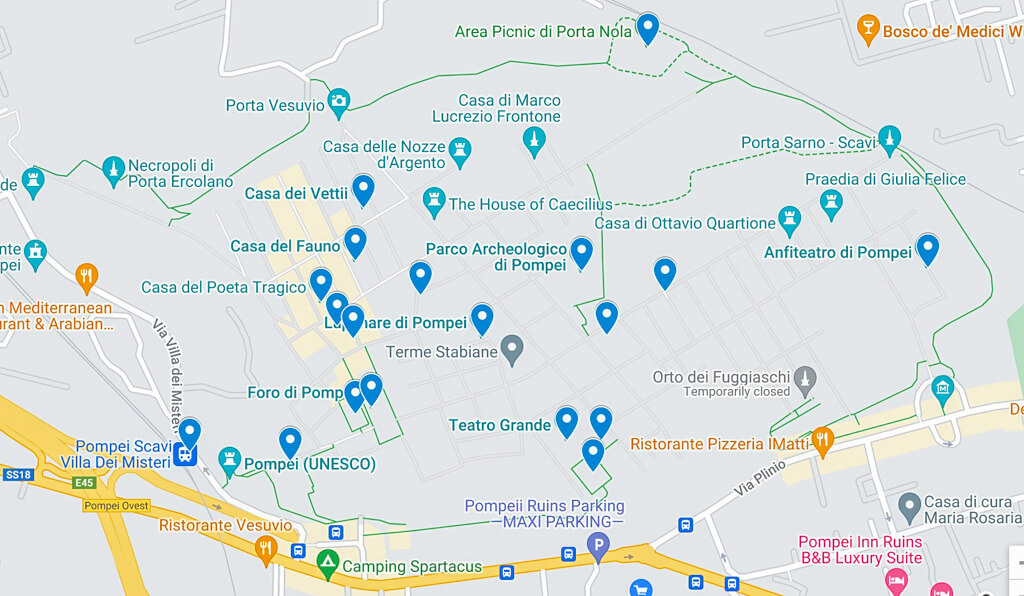
Click here for an interactive map of the Pompeii highlights we visited, including train stations and the main entrance.
NB despite being on site for nearly 3 hours with an excellent guide we still didn’t have time to get to the Amphitheatre, out to the east. Which might help you to appreciate the scale of the place.
A guided tour of Pompeii – do you need one?
Pompeii is a huge site, the size of the original town itself, but without any signposts worth speaking of, or explanatory information. It is very unlike a British historical site in this respect. It is also – obviously – in ruins and it can be hard to work out what you’re looking at.
I was visiting Pompeii Italy with my two students sons and we were all keen to learn so I decided in advance to book a private guide.
This is very much an individual choice. We noticed lots of group tours, big and small, as well as private guides, but that doesn’t mean you can’t manage without.
But to be honest I think going it alone is quite a daunting task, especially if you’re visiting with children or teens.
You’ll need to be good at following maps and also be able to use your imagination to visualise what each area once looked like.
On top of this, the ongoing preservation and excavation work at Pompeii means that some areas might be unexpectedly closed off and others unexpectedly open! The official guides know about this in advance, but it can come as a surprise to the general public.
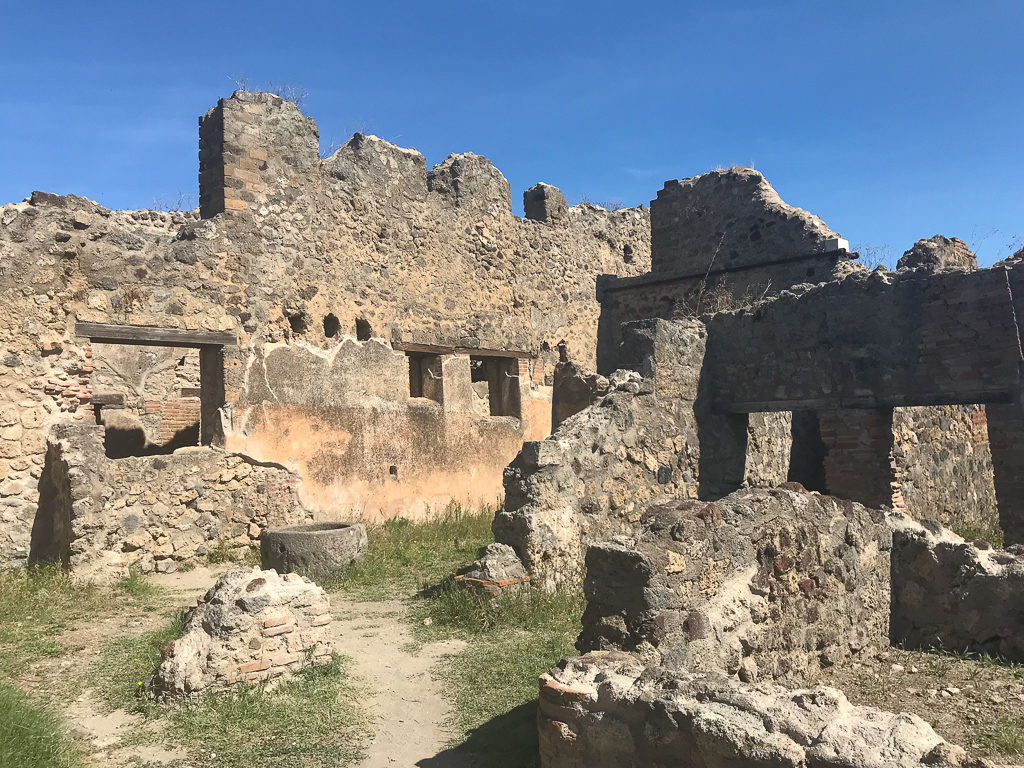
Self-guided tour of Pompeii
If you prefer to explore on your own, you can download an app and/or rent an audio guide at the site for €8.
It’s a good idea to do some reading in advance. Pompeii can seem overwhelming when you arrive and having a rough idea of the city plan and the sights that you’d like to see is a big help.
Pompeii has a new official guide and map of the site (edition 2023) that gives you an idea of its scale and major sights.
For a copy of Mary Beard’s Pompeii The Life of a Roman Town click here. This is a chunky paperback, but you can always get the Kindle edition, and it’s a really fascinating read that brings the town to life. Mary Beard is an academic who writes with wit and verve. “Disgracefully enjoyable,” says one of the reviewers. (As an Amazon Associate I earn from qualifying purchases.)
Of course the pluses of a DIY visit are that you can wander at your own pace and choose quieter areas to escape the crowds. Click below to book your Pompeii entrance tickets in advance.
For fast-track entrance tickets click here
How to Choose a Guide for Pompeii
Whether you book a private guide or a small or large group tour depends a lot on your level of commitment to the visit. If you’ve more than a passing interest in the story of Pompeii and the findings on the site then I’d recommend a private Pompeii guide or a small group tour.
If you just want to see the highlights and get help navigating the enormous site then you might be happy with a larger – and cheaper – tour. This Pompeii Express tour is very reasonably priced and is just one hour long.
The benefits of a Pompeii tour with a private guide
After tackling Rome without a guide I’d already decided to call on some expert help at Pompeii. We were lucky enough to find an expert private guide via our accommodation in Naples and I was very glad we did.
A private tour isn’t cheap but we spotted the benefits right from the start. Our expert in ancient history was an accredited Pompeii guide and her badge magicked us to the front of the ticket queue at the entrance. It also smoothed over the issue that Ed had brought his student ID card rather than passport as proof of age (there’s a reduced rate for EU citizens under 25 though it doesn’t apply to online purchases).
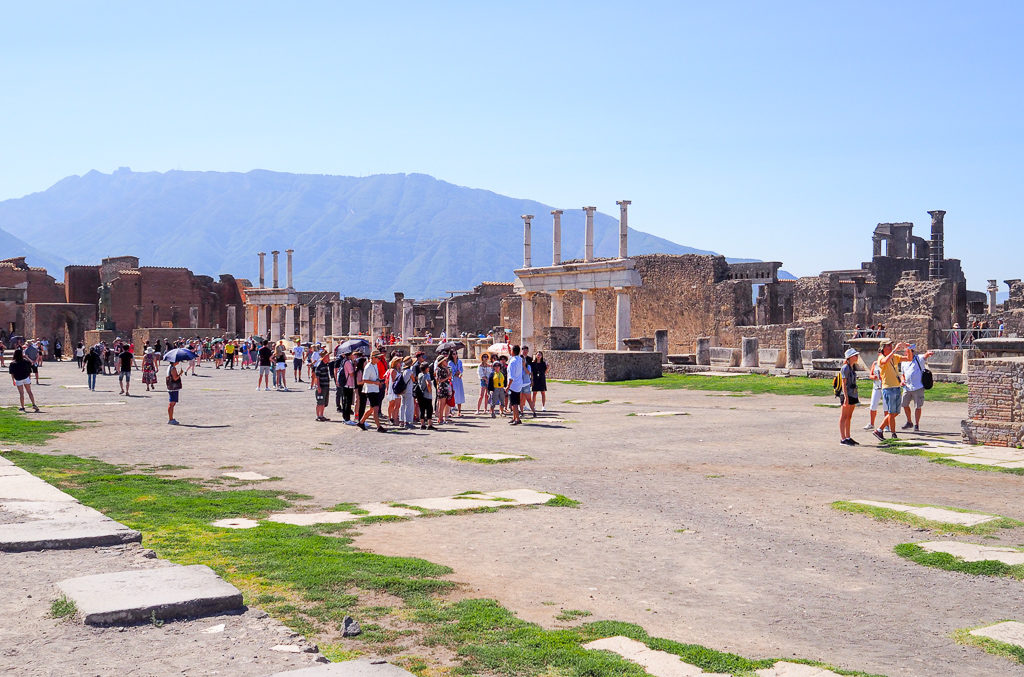
It’s great to have a friendly expert on hand who can decode the ruins and reveal all sorts of little details about life in the Roman town and also the current excavation work.
At the start we discussed what we’d most like to see. Even in September crowds gathered in the popular areas. But a group of four can be agile and we were whisked from one quiet location to another, staying out of range of big tour parties.
The official guides know the short cuts and which areas are closed off so they can tailor their tours accordingly.
With excellent English, our guide chatted knowledgeably and enthusiastically about every point of interest. At each stop she conjured up an imaginary picture of how it once looked in Roman times.
Three hours passed effortlessly and I don’t think we would have seen or appreciated half as much on our own.
How to book a private guide for Pompeii
Our guide can’t be booked online but this sounds like a very similar experience – and the reviews are excellent:
How to book a small group tour of Pompeii
Many small group tours take up to 20 people. This is still half the size of the bigger tours that will take as many as 40. So you can decide whether you’re happy in a larger group or would prefer a smaller, more personalised experience. Tours also vary between 1 to 3 hours.
Joining a tour when you arrive at Pompeii
You can also join an inexpensive group tour with an official guide at the ticket office. Don’t be tempted by the touts offering Pompeii tours outside the main gate! The official Pompeii guides, authorised by the Campania region, are to be found inside the site at the Porta Marina entrance ticket and information office. As we haven’t tried this I don’t know in practice how many are available but this could be a good option for an overview.
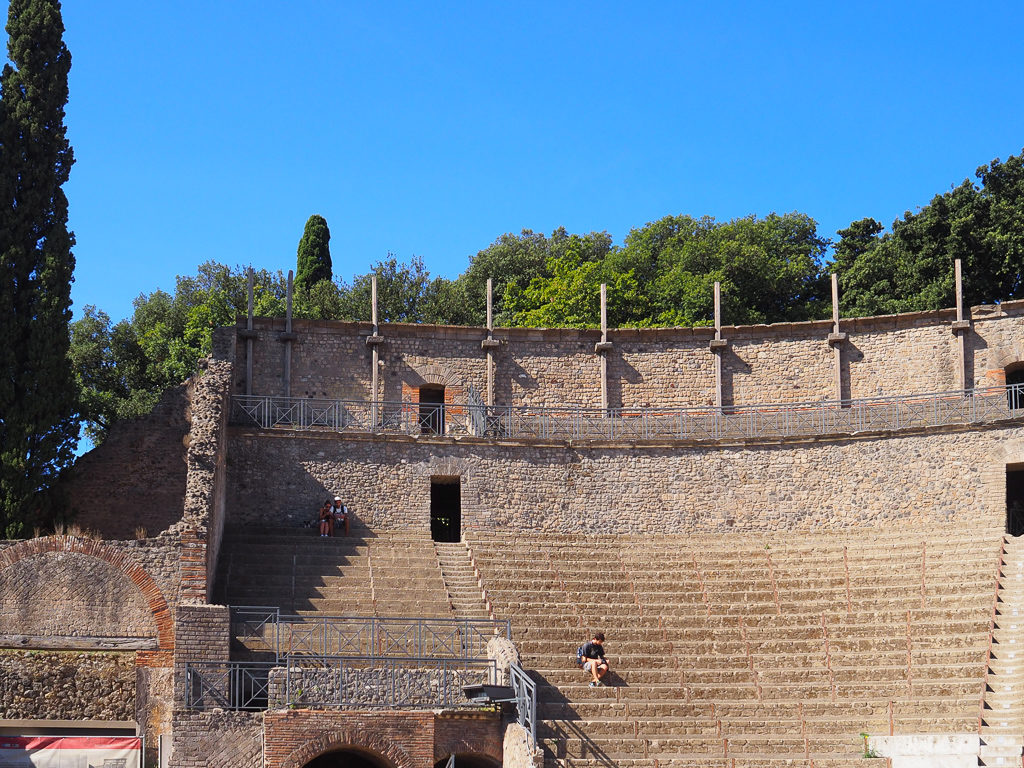
What to see in Pompeii
Pompeii is an entire ruined city, all 170 acres of it. There are literally hundreds of things to see and it is difficult to fit even the highlights into just 2 or 3 hours.
You will get the most out of your visit to Pompeii if you do some preparation in advance. The physical size of the archaeological park means that you’ll need a plan if you want to see all the highlights in a limited amount of time.
The main attractions include:
- The Forum with its temples, basilica and market halls
- Two theatres
- The huge amphitheatre
- Public baths
- Grand houses with decorative wall paintings, like the House of the Vettii and House of the Faun.
- Shops and a laundry
- The brothel
These are a few of our highlights but it’s not a complete list – you’ll find plenty of your own too.
The Garden of the Fugitives contains plaster casts of the voids made in the ash by the bodies of victims killed in the eruption. These haunting figures are a powerful reminder that Pompeii was the scene of a great tragedy. And you may not feel very comfortable viewing them.
The small museum on site has more plaster casts and artefacts, though most of the moveable treasures have been taken off-site, in particular to Naples’ Archeological Museum.
Visiting Pompeii Italy: favourite sights
This list is not by any means Pompeii’s major attractions. But these are some of the small details, pointed out by our guide, that really brought the city to life for me.
Walk along the streets of Pompeii in the footsteps of Romans
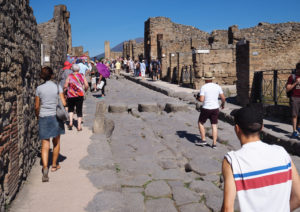
It’s the first thing you notice: these are the same roads and footpaths that were used by the Roman townspeople. You can see the grooves worn into the paving stones by cart wheels and stepping stones used by pedestrians. Look out for the lead piping along the edges of buildings that carried water around the town.
Pompeii streets may have operated a one-way system. Patterns of wear on the kerb stones show that carts went in a single direction down certain streets.
Pause at the shop fronts of the Roman fast food outlets
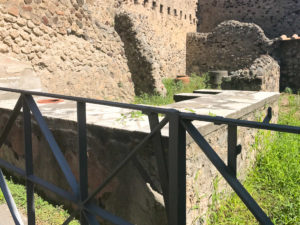
Kitchens weren’t really a thing for anyone but the rich, so poorer people bought takeaway food. You can see the counters that held pots containing provisions and the grooves in the thresholds for wooden doors.
Go to one of the Roman public baths
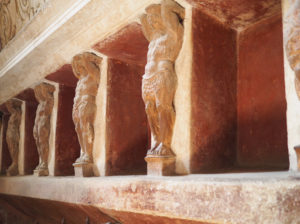
Everyone went to the public baths, which had separate rooms for men and women. In the Forum baths an elaborate brazier created underfloor heating whilst grooves in the arched ceilings helped to drain away water droplets so that they didn’t fall on peoples’ heads. The niches here probably held customers’ clothes.
Visit a bakery that was cooking panini
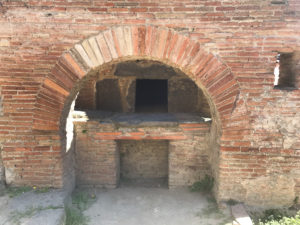
This bakery with its beautiful archway has millstones standing beside it to grind the grain. When the site was first revealed, archeologists found carbonised panini bread in the ovens.
Check out the gladiators’ quarters
There’s much controversy over the gladiators’ lodgings in Pompeii Italy. Excavators found the body of a wealthy lady in this all-male zone, but no-one knows if she was visiting a gladiator or taking shelter from the eruption.
See some of Pompeii’s fashionable interiors

The House of the Vettii is a great example, if you can stomach the enormous image of the fertility god, Priapus in the entrance hall. This fresco of Cupid riding a crab is in the atrium and the villa has expansive wall paintings of mythological scenes in very Farrow and Ball’y colours.
It’s quite astonishing how the brightly coloured frescoes and mosaics in some of Pompeii’s grandest establishments have survived 2000 years.
Be prepared for the Pompeii brothel
If the explicit imagery on the walls of some Pompeiian living rooms is startling to modern eyes, you can imagine what the brothels were like. Pompeii’s small Lupanare, or brothel, features a pictorial menu of services on its walls. Something to bear in mind when you decide whether to take a look inside with the family.
Don’t miss the guard dog
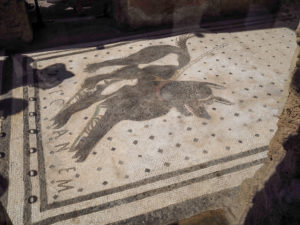
Dogs were man’s best friends, or at least guards, in Pompeii two thousand years ago. You can spot the mosaic lettering of Cave Canem or Beware of the Dog in several doorways. And the famous picture on the floor, here, is in the House of the Tragic Poet.
Or the wooden door
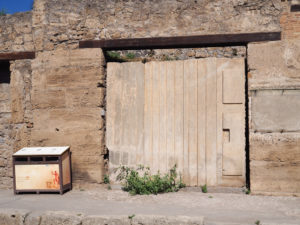
One sight that’s stuck with me is a plaster cast of a big wooden door, taken from a void in the ash left by the original. I’d have walked past it if our guide hadn’t pointed it out. It looks like any old patched up store house door, except the original of this one was 2000 years old.
Our guided tour of Pompeii showed us that we’re very unlike the Romans in many ways, not least our views on privacy, what constitutes entertainment and how to live in a house.
But in terms of constructing a door not much has changed!
Practical tips for visiting Pompeii
Wear flat walking shoes with grippy soles. This is surprisingly important: the ancient cobbles are worn to a slippery shine in places.
Bring water bottles, you can easily refill them on site.
Don’t forget suncream and sunhats as there’s very little shade in Pompeii and it can get very hot in the summer months.
Pack snacks or lunch Pompeii has a number of picnic areas. It also has a cafeteria serving pizza slices etc.
And check the dos and don’ts on the official website before you set off. There are strict rules about the size of bag you can bring on site for instance.
Make a note of where the toilets are to help avoid standing in a long queue.
Start early in the morning at opening time to avoid the crowds and the heat of the sun at midday.
Visiting with young children? Be aware that there’s p*rn-style imagery in some of the frescoes as well as the brothel. So plan ahead if you’d rather avoid it.
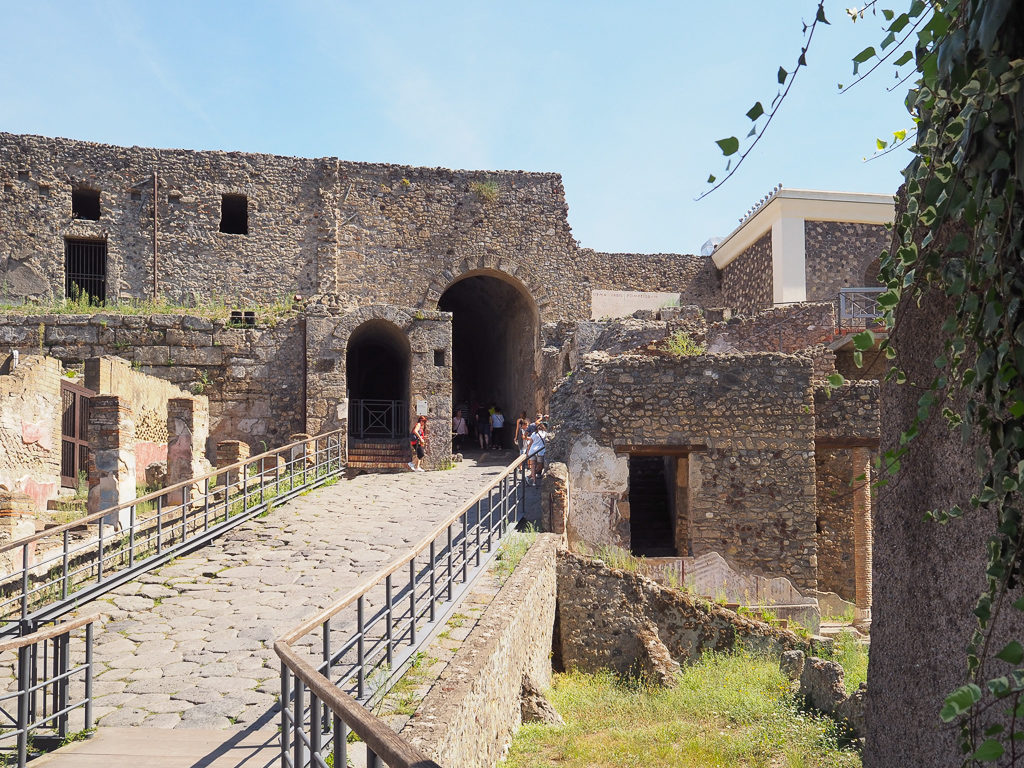
Where to stay to visit Pompeii
The Pompeii archeological site lies on the west coast of Italy in the Campania region. It is 150 miles south of Rome, 15 miles south of the city of Naples and a similar distance north of the seaside resort of Sorrento. So you can choose to take a day trip to Pompeii from Naples, Sorrento or even Rome.
Naples is a big, bustling vibrant city that holds many treasures in its own right. We loved exploring it and visiting Pompeii was a key part of our Naples itinerary. Naples to Pompeii was a straightforward journey and after visiting the Pompeii archaeological park and then hiking up Vesuvius we were glad we only had a short journey home.
If you prefer a more relaxing stay, Sorrento is a lovely little seaside town. It’s very geared up to tourists and more expensive than Naples, but it’s an attractive base for exploring the region.
High speed trains between Rome and Naples take 1 hr 20 mins, which makes the possibility of a day trip to Pompeii feasible if you can get the timing right. This Rome to Pompeii Tour by high speed train with wine and lunch does the travel planning for you with a comfortable train and connecting shuttle bus, a knowledgeable guide and a wine-tasting and lunch in a vineyard. The reviews are excellent: check them out here along with availability and booking information.
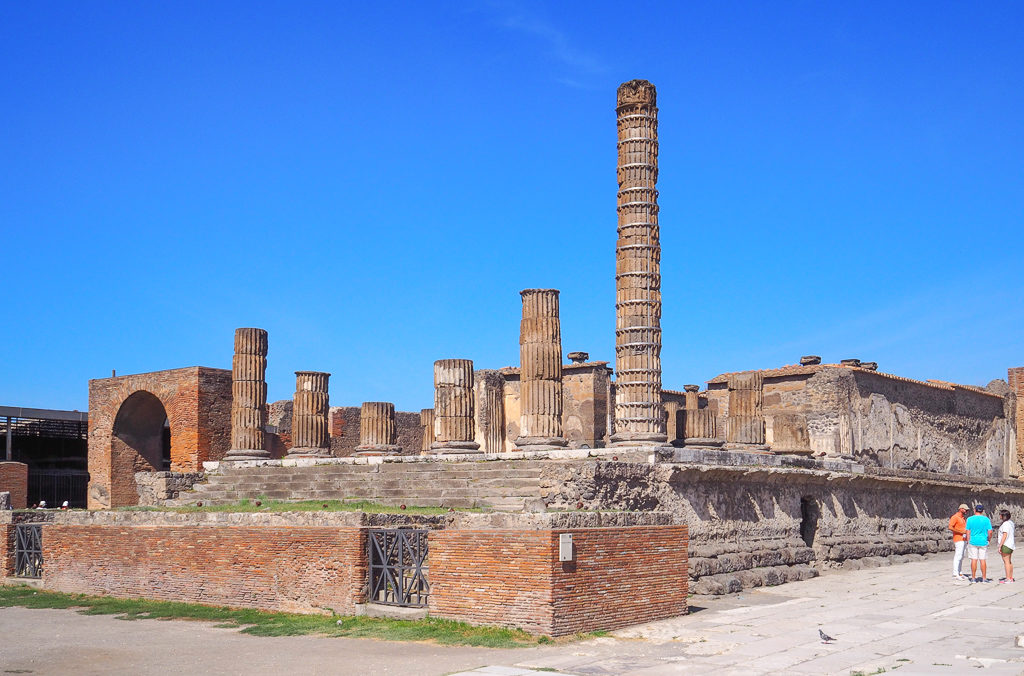
Naples to Pompeii: plan your journey
It’s just a 30 minute bus or train ride to Pompeii from Naples.
Naples to Pompeii train
There are three choices of train to Pompeii from Naples.
The Circumvesuviana, a generally hot and crowded local train, runs two or three times an hour and takes 40 minutes from Naples to Pompeii. It’s cheap but well worn and the lack of air-conditioning, the crowds and the danger of pickpockets is off-putting to many. You can’t reserve tickets in advance and will need to pay cash at the station. It leaves from Naple’s Porta Nolana station (you have a better chance of getting a seat from here) and also stops at the Piazza Garibaldi which is part of the Napoli Central station. The stop you need for the archeological site is the Pompei Scavi-Villa dei Misteri station.
The Metropolitano is a commuter train and goes to Pompei, the station in the modern town of Pompei (note the different spelling), as opposed to Pompei Scavi. From here it’s a 10 minute walk to the Pompeii Archaeological Park.
The Campania Express train is a tourist train that runs, less frequently and with fewer stops, on the Circumvesuviana line. It costs around €15 one way, €25 for the round trip and takes 30 minutes to Pompeii. You can buy tickets online on the EAV Campania website or at least 20 minutes in advance from the Circumvesuviana ticket office at Porto Nolana or Piazza Garibaldi stations. The big bonus here is that the carriages are air-conditioned and you will get a seat.
Naples to Pompeii bus
Most advice about transport to Pompeii will tell you to catch the train. But we travelled to Pompeii from Naples with our guide who recommended that we take a bus instead. We caught the bus at around 9 am from the SITA bus station by the harbour, off Via Nuova Marina. The bus was only half full that day and it was a quick and comfortable 30 minute journey – with air conditioning! As we were staying in Naple’s Centro Storico just a ten minute walk from the harbour this was much quicker for us than going to the railway station.
Local bus routes and times are subject to change. If you’re staying in Naples ask for more details at a tourist information office or go to the terminal at the harbour in advance. NB we didn’t try to catch a bus back as we went on to Vesuvius then returned to Naples by train.
Take a shuttle bus to Pompeii from Naples
For peace of mind this is an easy option to book ahead. This round trip shuttle bus has two departure times a day from Naples and the journey takes around 40 minutes to Pompeii. You are then free to explore the site for 2.5 to 3 hours before your return to Naples. Read reviews, check availability and book the Round Trip Shuttle Bus to Pompeii.
Book a tour of Pompeii that includes transport from Naples
The easiest way to travel to Pompeii from Naples is on a guided tour that includes transport. This small group tour with skip-the-line tickets gets very good reviews which praise the knowledgeable guides. Read reviews, check availability and book the From Naples: Pompeii Guided Tour with Skip-the-Line tickets
Visit Vesuvius from Pompeii
We spent the morning at Pompeii then caught a train to Ercolano for lunch and a bus to Vesuvius. There is time to visit both Pompeii and Vesuvius on the same day. If you’d prefer an organised full day tour this option includes coach travel, a guide and time for lunch:
For a guided day trip to Pompeii and Vesuvius with return coach transport to Naples, click here
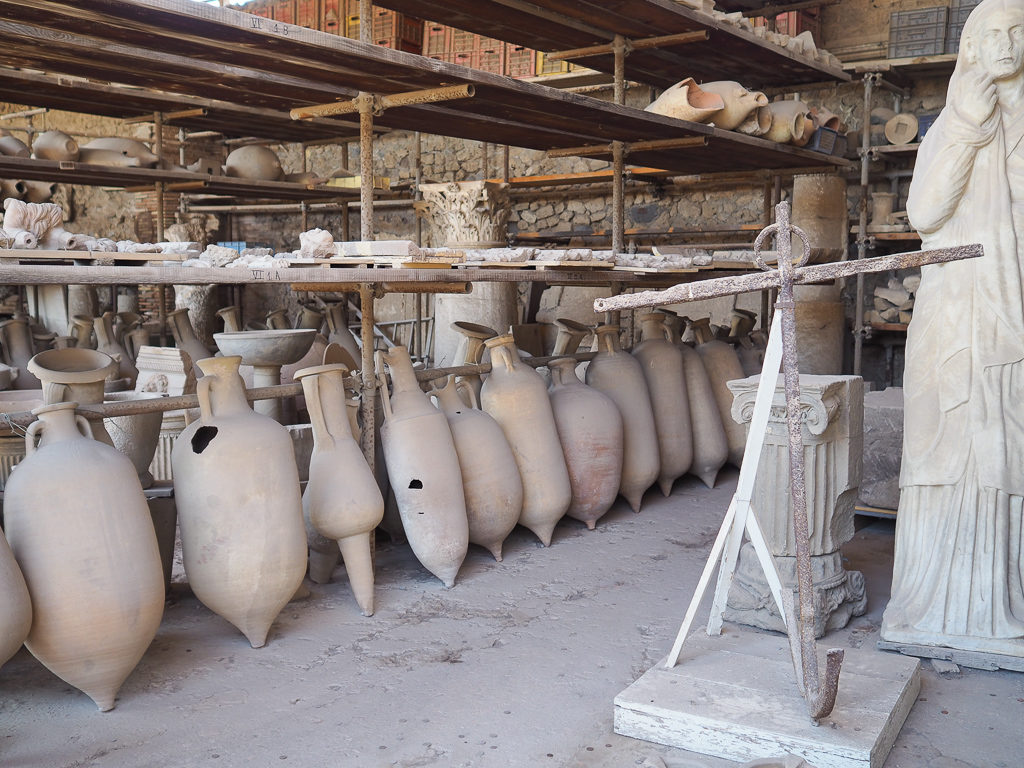
Pompeii FAQs
Many people who lived in Pompeii actually escaped the eruption because they left the city before it happened. Months of earth tremors preceded the blast and people may have moved out because of this. As many as 20,000 people might have lived in Pompeii whereas 1500 to 2000 people died in the disaster.
No one in Pompeii realised that Vesuvius was a volcano until it erupted. Several earthquakes shook the region in the years leading up to 79AD but the volcano had been quiet for a long time. Poignantly there wasn’t even a word for volcano in Latin at that time.
About 30% of the site has not been excavated and there are clearly still discoveries to be be made that will throw new light on the city. A recent excavation has revealed a scribbled charcoal message on a wall that includes a date. It suggests the eruption must have happened in November not August as was generally thought.
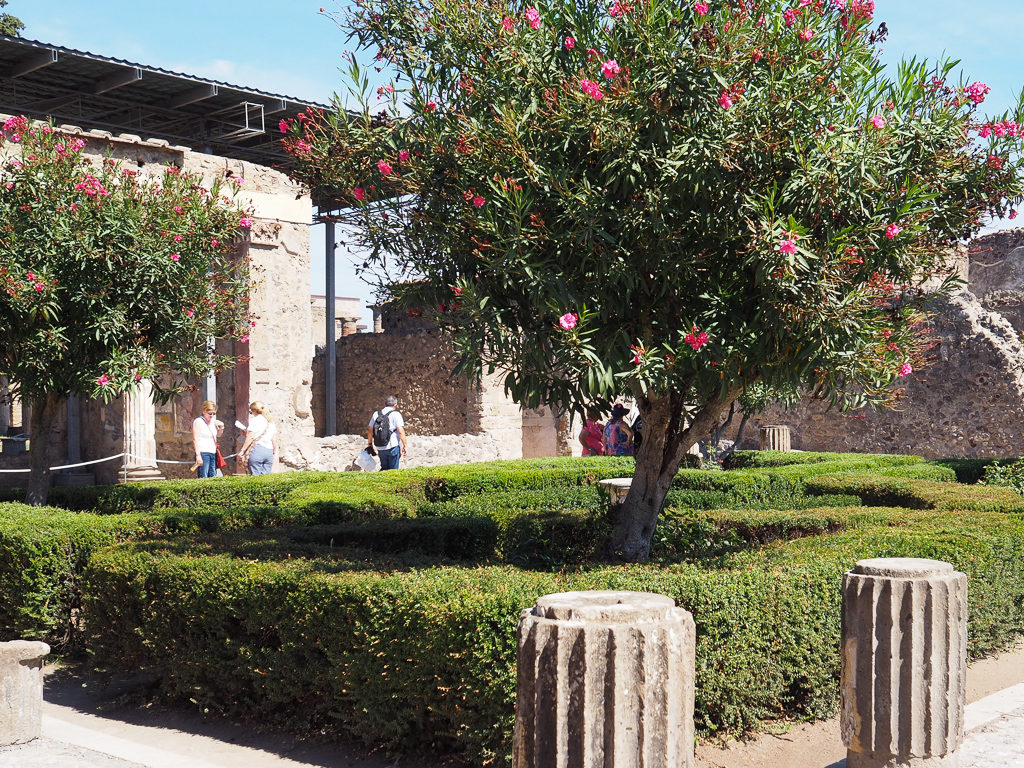
Please note that all visitor information here is for guidance only. Please check the relevant websites for the most up to date information eg. accommodation details, tickets, entrance requirements, opening times etc.
What to read next
Pompeii was part of our Naples Itinerary. Find out our top things to do in this vibrant and beautiful city.
We also took a day trip from Naples to Procida, a hidden gem island off the Amalfi coast with pastel-coloured fishing villages
Find out more about the hottest places in September in Europe.
Discover Maratea Italy, a hideaway seaside gem in Basilicata with Amalfi-style coastal views.
Find out our tips on beating the queues and visiting Florence, Italy on a budget, here.
Get the lowdown on all the best things to do in Rome with teenagers (or without!)
And, of course, the top things to do in magical Venice with teenagers too.
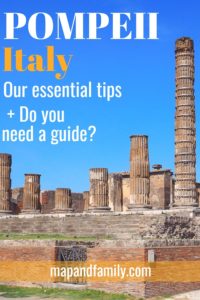
Like this post? Please pin this to save and share to Pinterest

About the author Nancy Roberts is a former women’s magazine editor and writer. She lives in London and is mum to two 20-something boys. In Map&Family she shares info and inspiration for curious travellers: singles and couples as well as families travelling with teens and young adults.
All photos are all rights reserved. Please do not reproduce these photos without prior written permission


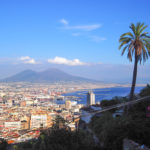


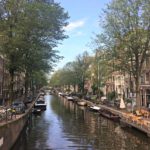
Emma Raphael says
Pompei is somewhere I desperately want to see, although it’s obviously so sad, the history captured is just fascinating! I love the fact that you can tour it yourself, but I really love private tours of places like this as I think we all learn so much more. We did a private tour of Rome with the most wonderful archaeologist once, let me know if you want her details for your next visit! 😀 Thanks so much for joining in with #CulturedKids
Map & Family says
Thanks so much Emma, I’ll remember that. We don’t always use guides but we did miss a trick in our visit to the Colosseum. So I didn’t want to risk going to all the trouble to get to Pompeii and then not really understand what we were looking at. Our lovely guide gave us all sorts of extra tips too about transport, things to see in Naples, places to eat etc.
the Curious Pixie says
I so want to visit Pompeii. Good tip re. the porn star imagery and brothel. Had to no idea #CulturedKids
Map & Family says
Just worth knowing where not to look to avoid awkward questions 😂. At the Naples museum it’s all handily kept behind a big iron gate so there’s plenty of warning.
Trish says
I’ve had two trips to Pompeii – once in the 1970s when I was about 13 on a trip with my family. We walked into the House of Vettii and I remember much pointing and giggling until I was marched out!
The second time was in 2010 when my son was 10. It was the brothel signs that caught us off-guard that time and I still pointed and giggled!
#culturedkids
Map & Family says
It’s the little carvings in the pavements isn’t it! There’s no escaping those 😂
Trish says
My mistake – it was 2006 the second time!
Map & Family says
😀
Scarlett Roitman says
I still remember the heat in Pompeii, all those years ago (I think I was about 10!). Water is a definite necessity. I didn’t realise the Pompeiians were so naughty! Tut tut. Thanks for a wonderful tour of Pompeii, makes me want to visit again. #CULTUREDkids
Map & Family says
Thanks Scarlett! I was reading the Mary Beard book at the time and she really does help to get your head round the way the Romans perceived things differently to us in quite fundamental ways!
Nell (Pigeon Pair and Me) says
I think this will be a brilliant trip for my two, in a year or two when they can properly appreciate it. I’m hoping to dodge any awkward questions about the brothel, though 🙂
Map & Family says
😂 Indeed, I’m quite glad not to have had to worry about that given the advanced ages of my boys now! Luckily you can easily avoid the brothel!
Annabel says
Great post! I visited Pompeii as a student and I’d love to take my older son, he loves history and volcanoes! I think a guide is definitely worth paying for. #Culturedkids
Map & Family says
Thanks Annabel, it definitely helped to bring it to life for us
scots2travel says
I was fascinated and heartbroken by Pompeii. Sure my kids would be too, and I hope to return with them. The ash frozen in time as it settled on people, leaving hollow eery statues would get to them as much as it did to me.
Exploring a whole town like that is the best way to learn. #culturedkids
Map & Family says
It’s tragic. Visitors are buffered from it a bit by the 2000 years that have passed but the plaster casts really bring it home.
Leona says
I was shocked when we visited Pompeii with all of the nudes etc! I am desperate to return #fearlessfamtrav
Map & Family says
I was a bit surprised by the chap in the hallway at the house of the Vettii 😂
Catherine’s Cultural Wednesdays says
Pompeii is somewhere that I really really want to go #CulturedKids
Map & Family says
Herculaneum is worth seeing too 🙂
Cristina - Memories of the Pacific says
I’d love to visit Pompeii, there’s so much history! I loved learning more about it, the facts you mention are really interesting.
PS- l’m in love with your blog template. Maps are one of my favorite things!
Map & Family says
Thank you! Yes I love maps too 😀
Nicky@Go Live Young says
Pompeii is somewhere we really want to go, although appreciate it was a devastating event. We’ve found private tours to be totally worthwhile for kids when visiting historic sites, as you get so much information which keeps them interested, rather than just wondering around! Thanks so much for linking up to #fearlessfamtrav
Map & Family says
Thanks Nicky, yes I agree re private tours – a good guide knows how to capture everyone’s imagination.
Carly says
Sounds fascinating. Do you think it’s worth the 2.5 hr trip there & then back if we were based in Rome for the week?
Map & Family says
Possibly depends on the time of year and how good you all are at travelling? We arrived at opening time but even in September it was busy by lunchtime. Have you thought of Ostia Antica? It’s the archeological site of the harbour of Ancient Rome and about 20 miles outside Rome (a little more than an hour by train). We haven’t been yet simply because we ran out of time but we’d go on another visit. It’s also the place where the Caroline Lawrence children’s books are set. If you loved it you might then decide to do the big trip to Pompeii? https://www.ostia-antica.org/